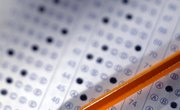The Armed Services Vocational Aptitude Battery (ASVAB) test was introduced in 1968, and since then, more than 40 million people have taken the ASVAB test. Today, more than 1 million people each year take the ASVAB test. The test measures developed ability and tries to predicts future areas of success in the military. There are several different types of scores that are computed as a result of the ASVAB test, and each score means something different.
Standard Score Components
The four ASVAB subtests include Arithmetic Reasoning (AR), Mathematics Knowledge (MK), Paragraph Comprehension (PC) and Word Knowledge (WK). These four tests are each assigned what is called a Standard Score. Standard Scores are relative to a national sample of people aged 18 to 23. Approximately 5 percent of the sample of population scores at or above a Standard Score of 50. About 16 percent of the population scores at or above a 60.
Understanding AFQT Scores
Those who take the ASVAB also receive a score on the Armed Forces Qualification Test (AFQT). AFQT scores use the standards scores from the four subtests, reported as percentiles between 1-99. For example, an AFQT score of 80 would mean that the examinee scored as well as or better than 80 percent of a nationally representative sample of people, 18 to 23 years of age. AFQT scores are further divided into categories. Category I includes scores in the 93-99 range. Category II scores are in the 65-92 range. Category IIIA scores are in the 50-64 range, while Category IIIB scores are in the 31-49 range. Category IV is divided into three subcategories: IVA includes scores from 21-30; IVB includes scores from 16-20; IVC scores range from 10-15. Finally, Category V scores range from 1-9.
Interpreting Line Scores
The AFQT score is what qualifies a person for enlistment. However, the scores on the ASVAB subtests determine the jobsf for which the examinee will qualify. The subtest scores are put into combinations that make up the composite, or line, scores. Each military branch determines the minimum line scores required to successfully complete different job training programs. Recruiters and job-placement specialists use these scores, with eligibility for security clearance, medical considerations and physical fitness, to match applicants to the military job that best suits them.
Decoding P&P and CAT-ASVAB
The pencil-and-paper (P&P) ASVAB tests all examinees on the same items, regardless of the examinee's individual ability level. Items on the test range from very easy to very hard, but, because examinees with high abilities usually answer most items correctly, the test is inefficient in accurately measuring examinees' abilities. To better identify examinees' strengths, the Computer Adaptive Test (CAT) ASVAB is also used. The CAT-ASVAB test uses items that range from very easy to very difficult, but the items are tailored to each examinee's previous answers. If an test question is answered correctly, examinees are given the next question, which is designed to be more difficult. If the question is answered incorrectly, the following question is designed to be easier. The test questions continue until time runs out or until the examinee completes the test. The final score is figured according to the examinee's responses.
Related Articles
Writer Bio
Now an English teacher, Allison Jensen began writing in 1999. She has been published in high school newspapers and yearbooks and is responsible for the production of the newspaper and yearbook where she teaches. She holds a Bachelor of Arts in English/secondary education from the University of Illinois at Urbana-Champaign.











